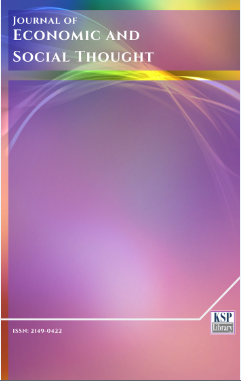The Informal Aspects of the Activity of Countries Studied Through Social Accounting and Socio-Demographic Matrices
Abstract
Abstract. Approaches based on Social Accounting Matrices (SAMs) and Socio-Demographic Matrices (SDMs) will be presented as a way of capturing relevant networks of linkages and the corresponding multiplier effects, which can subsequently be used for modelling the activity of the countries to be studied. Emphasis will be placed on the activity of household unincorporated enterprises, also known as informal enterprises. Based on methodological principles derived mainly from the works of Richard Stone, this study will be developed in a matrix format, including, on the one hand, people – represented by a SDM – and, on the other hand, activities, products, factors of production and institutions – represented by a SAM. The exposition will be accompanied by an application to Portugal, in which different scenarios will be briefly presented, involving changes in incomes and expenditures. The macroeconomic effects of these changes will be summarised in the form of changes in the macroeconomic aggregates: Gross Domestic Product, Gross National Income and Disposable Income.
Keywords. Social Accounting Matrix; Socio-Demographic Matrices; Informal Economy.
JEL. E01; E16; J11.
Keywords
References
Inter-Secretariat Working Group on National Accounts (United Nations, European Commission, International Monetary Fund, Organisation for Economic Cooperation and Development and World Bank) – ISWGNA (2009), System of National Accounts 2008, Series F, No. 2, Rev. 5,United Nations, New York.
Keuning, S., & Ruijter W. (1988). Guidelines to the construction of a social accounting matrix, Review of Income and Wealth, 34(1), 71-100.doi. 10.1111/j.1475-4991.1988.tb00561.x
Pyatt, G. (2001). Some early multiplier models of the relationship between income distribution and production structure, Economic Systems Research, 13(2), 139-163.doi. 10.1080/09537320120052434
Pyatt, G. (1999). Some relationships between T-accounts, input-output tables and social accounting matrices, Economic Systems Research, 11(4), 365-387.doi. 10.1080/09535319900000027
Pyatt, G. (1991a). SAMs, the SNA and National Accounting Capabilities, Review of Income and Wealth, 37(2), 177-198.doi. 10.1111/j.1475-4991.1991.tb00353.x
Pyatt, G. (1991). Fundamentals of social accounting, Economic Systems Research, 3(3), 315-341.doi. 10.1080/09535319100000024
Pyatt, G. (1988). A SAM approach to modeling, Journal of Policy Modeling, 10(3), 327-352.doi. 10.1016/0161-8938(88)90025-7
Pyatt, G. (1985). Commodity balances and national accounts: A SAM perspective, Review of Income and Wealth, 31(2), 155-169.doi. 10.1111/j.1475-4991.1985.tb00505.x
Pyatt, G., & Roe, A.(1977). Social Accounting for Development Planning with Special Reference to Sri Lanka, Cambridge University Press, Cambridge, UK.
Pyatt, G., & Round, J. (2012). Distributional invariance and the design of SAMs, Economic Systems Research, 24(3), 251-273.doi. 10.1080/09535314.2012.665359
Pyatt, G., & Round, J. (1985). Accounting and fixed price multipliers in a social accounting matrix framework, in G. Pyatt, and J. Round, (coord.), Social Accounting Matrices. A Basis for Planning. A World Bank Symposium, World Bank, 52-69.
Round, J. (2003).Constructing SAMs for development policy analysis: Lessons learned and challenges ahead, Economic Systems Research, 15(2), 161-183.doi. 10.1080/0953531032000091153
Round, J. (1994). The structure of the European economy: A SAM perspective, in J. Round, (ed.), The European Economy in Perspective. Essays in Honour of Edward Nevin, University of Wales Press, Cardiff, 59-83.
Round, J. (1991). A SAM for Europe: Problems and perspectives, Economic Systems Research, 3(3), 249-268.doi. 10.1080/09535319100000021
Santos, S. (2014). Studying the informal aspects of the activity of countries with Social Accounting and Socio-Demographic Matrices.WorkingPaper No.17/2014/ DE (Departamento de Economia) /UECE (Unidade de Estudossobre a Complexidade em Economia) - ISEG (InstitutoSuperior de Economia e Gestão) /UL (Universidade de Lisboa), 21p.
Santos, S. (2013). Socio-Economic Studies with Social Accounting and Socio-Demographic Matrices.An applicationtoPortugal. WorkingPaper No.16/2013/ DE (Departamento de Economia) /UECE (Unidade de Estudossobre a Complexidade em Economia) - ISEG (InstitutoSuperior de Economia e Gestão) /UL (Universidade de Lisboa), 44p.
Santos, S. (2012). A SAM (Social Accounting Matrix) approach to the policy decision process".WorkingPaper No.28 /2012/ DE (Departamento de Economia) /UECE (Unidade de Estudossobre a Complexidade em Economia) - ISEG (InstitutoSuperior de Economia e Gestão) /UTL (UniversidadeTécnica de Lisboa), 83p.
Santos, S. (2009). From the System of National Accounts (SNA) to a Social Accounting Matrix (SAM)-Based Model.An Application to Portugal, Edições Almedina, Coimbra-Portugal, 194p.
Santos, S. (2007). Modelling economic circuit flows in a social accounting matrix framework. An application to Portugal, Applied Economics, 39(14), 1753-1771.doi. 10.1080/00036840500447864
Santos, S. (2004). Portuguese net borrowing and the government budget balance. A SAM approach, Journal of Policy Modeling, 26(6), 703-717. doi. 10.1016/j.jpolmod.2004.04.014
Stone, R. (1986). Nobel Memorial Lecture 1984. The Accounts of Society, Journal of Applied Econometrics, 1(1), 5-28.doi. 10.1002/jae.3950010103
Stone, R. (1986a). Demographic input-output: An extension of social accounting, in: I. Sohn (coord), Readings in Input-Output Analysis: Theory and Applications, Oxford University Press, USA, 151-172.
Stone, R. (1985). The disaggregation of the household sector in the national accounts, in G. Pyatt, and J. Round, (coord.), Social Accounting Matrices. A Basis for Planning. A World Bank Symposium, World Bank, 145 - 185.
Stone, R. (1982). Working with what we have: how can existing data be used in the construction and analysis of socio-demographic matrices?,Review of Income and Wealth, 28(3), 291-303. doi. 10.1111/j.1475-4991.1982.tb00618.x
Stone, R. (1981). Aspects of Economic and Social Modelling, Editions Droz, Genève (Suisse), 154p.
Stone, R. (1975). Towards a System of Social and Demographic Statistics, Studies in Methods, Series F, Nº18, United Nations, New York, 198p.
Stone, R. (1973). A System of Social Matrices, Review of Income and Wealth, 19(3), 143-166. doi. 10.1111/j.1475-4991.1973.tb00879.x
Stone, R. (1971). An Integrated System of Demographic, Manpower and Social Statistics and its Links with the System of National Economic Accounts, Sankhyā: The Indian Journal of Statistics, 33(1-2), 1-184.
Stone, R. (1966). The social accounts from a consumer's point of view. An outline and discussion of the revised United Nations System of National Accounts, Review of Income and Wealth, 12(1), 1-33. doi. 10.1111/j.1475-4991.1966.tb00709.x
DOI: http://dx.doi.org/10.1453/jest.v3i1.620
Refbacks
- There are currently no refbacks.
Journal of Economic and Social Thought - J. Econ. Soc. Thoug. - JEST - www.kspjournals.org
ISSN: 2149-0422
Editor: [email protected] Secretarial: [email protected] Istanbul - Turkey.
Copyright © KSP Library




